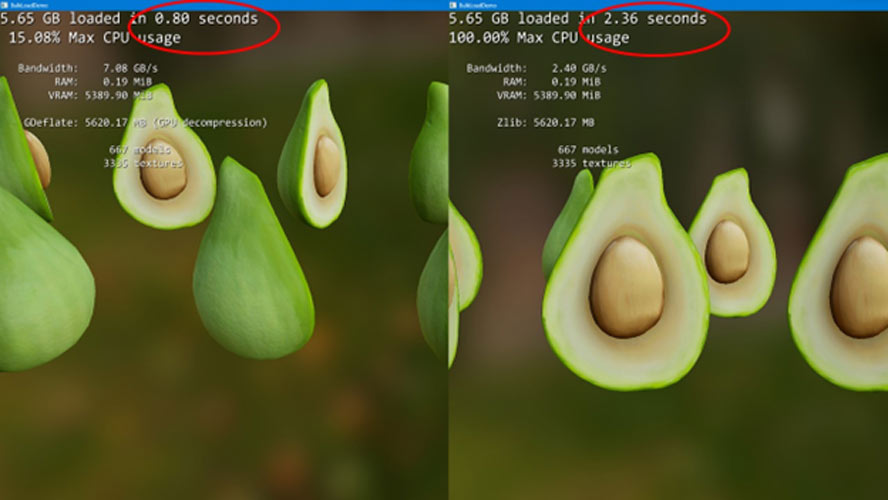
DirectStorage Performance Compared: AMD vs Intel vs Nvidia
Microsoft’s DirectStorage 1.1 application programming interface is available for Windows-based computers, the latest graphics cards, and advanced NVMe solid-state drives. So, it is time to find out what hardware best handles GPU decompression, which is one of the most exciting features of DirectStorage 1.1. Fortunately, Compusemble has developed an appropriate benchmark, whereas PC Games Hardware used it to uncover some interesting findings.
Microsoft’s DirectStorage 1.1 has several critical performance-boosting features, but the main objectives of this API are to reduce CPU load when dealing with NVMe requests. It also saves valuable CPU cycles for other workloads and handles game asset decompression via highly-parallel GPUs with little OS intervention and low CPU utilization. In addition, the usage of DirectStorage asset compression and decompression algorithms allows for transferring more data than the storage medium (i.e., SSD) is capable of, which greatly reduces loading times.
Meanwhile, GPU hardware handles DirectStorage decompression algorithms differently, so PCGH decided to find out which of the latest GPUs — AMD’s Radeon RX 7900 XT, Intel’s Arc A770, or Nvidia’s GeForce RTX 4080 — is better for asset decompression. They took Compusemble’s benchmark and ran it on the graphics cards and on Intel’s Core i9-12900K CPU.
| Row 0 – Cell 0 | PCIe 4.0 x4 (7.9GB/s) | PCIe 3.0 x4 (3.9GB/s) | SATA (0.6 GB/s) |
| Radeon RX 7900 XT | 14.6 GB/s | 12.6 GB/s | 1.47 GB/s |
| Arc A770 16GB | 16.8 GB/s | 13.9 GB/s | 1.64 GB/s |
| GeForce RTX 4080 | 15.3 GB/s | 12.7 GB/s | 1.47 GB/s |
| Core i9-12900K @ 5.20 GHz | 5.2 GB/s | 5.2 GB/s | 1.47 GB/s |
The first thing that strikes the eye is that all GPUs handle decompression at least 2.4 times better than the Core i9-12900K processor. Meanwhile, Intel’s Arc A770 is noticeably better than AMD’s Radeon RX 7900 XT and Nvidia’s GeForce RTX 4080 regarding GPU asset decompression. In the best-case scenario, the A770 can transfer/decompress assets at a rate of 16.8 GB/s, whereas the RX 7900 XT comes third with a 14.6 GB/s rate (13% behind the leader).
Whether an AMD, Intel, or Nvidia GPU is used, actual loading times are reduced by an order of magnitude — from 5 seconds to 0.5 seconds, according to PCGH. Therefore, given how close the decompression rate results of graphics processors are, it does not really matter which GPU is used — they are all up to the task and are generally good enough to significantly improve the gaming experience.



